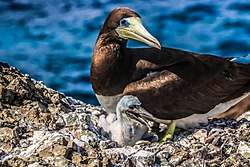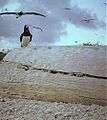Brown booby
| Brown booby | |
|---|---|
 | |
| With its baby in São Pedro and São Paulo Archipelago, Pernambuco, Brazil | |
| Scientific classification | |
| Kingdom: | Animalia |
| Phylum: | Chordata |
| Class: | Aves |
| Order: | Suliformes |
| Family: | Sulidae |
| Genus: | Sula |
| Species: | S. leucogaster |
| Binomial name | |
| Sula leucogaster (Boddaert, 1783) | |
The brown booby (Sula leucogaster) is a large seabird of the booby family, Sulidae. They present sexual dimorphism. The female booby reaches about 80 centimetres (31 in) in length, its wingspan measures up to 150 cm (4.9 ft), and they can weigh up to 1,300 g (2.9 lb). The male booby reaches about 75 centimetres (30 in) in length, its wingspan measures up to 140 cm (4.6 ft), and they can weigh up to 1,000 g (2.2 lb).[2]
Taxonomy
The brown booby was described by the French polymath Georges-Louis Leclerc, Comte de Buffon in his Histoire Naturelle des Oiseaux in 1781.[3] The bird was also illustrated in a hand-coloured plate engraved by François-Nicolas Martinet in the Planches Enluminées D'Histoire Naturelle which was produced under the supervision of Edme-Louis Daubenton to accompany Buffon's text.[4] Buffon did not include a scientific name with his description but in 1783 the Dutch naturalist Pieter Boddaert coined the binomial name Pelecanus leucogaster in his catalogue of the Planche Enluminées.[5] The type locality is Cayenne in French Guiana.[6] The current genus Sula was introduced by the French zoologist Mathurin Jacques Brisson in 1760.[7][8] The word Sula is Norwegian for a gannet; the specific leucogaster is from Ancient Greek leuko for "white" and gastēr for "belly".[9]
There are four recognised subspecies:[10]
- S. l. leucogaster (Boddaert, 1783) – Caribbean and Atlantic Islands
- S. l. brewsteri Goss, 1888 – Pacific coasts of USA and Mexico
- S. l. etesiaca Thayer & Bangs, 1905 – Pacific coasts of Central America and Colombia
- S. l. plotus (Forster, JR, 1844) – Red Sea through the Indian Ocean to the west and central Pacific
Description
The booby's head and upper body (back) is covered in dark brown or black, with the remainder (belly) being a contrasting white. The juvenile form is gray-brown with darkening on the head, wings and tail. While these birds are typically silent, bird watchers have reported occasional sounds similar to grunting or quacking. Their beaks are quite sharp and contain many jagged edges. They have short wings and long, tapered tails.
Ecology
This species breeds on islands and coasts in the pantropical areas of the Atlantic and Pacific oceans. They frequent the breeding grounds of the islands in the Gulf of Mexico and the Caribbean Sea. This bird nests in large colonies, laying two chalky blue eggs on the ground in a mound of broken shells and vegetation. It winters at sea over a wider area.
Brown booby pairs may remain together over several seasons. They perform elaborate greeting rituals, and are also spectacular divers, plunging into the ocean at high speed. They mainly eat small fish or squid which gather in groups near the surface and may catch leaping fish while skimming the surface. Although they are powerful and agile fliers, they are particularly clumsy in takeoffs and landings; they use strong winds and high perches to assist their takeoffs.
Gallery
- Adult, French Frigate Shoals

 Stick nest built on the ground
Stick nest built on the ground In flight in the Gulfo Dulce, Costa Rica
In flight in the Gulfo Dulce, Costa Rica Flock of boobies at Johnston Atoll National Wildlife Refuge
Flock of boobies at Johnston Atoll National Wildlife Refuge Pacific coast of Costa Rica
Pacific coast of Costa Rica- Pair at Islas Marietas National Park, Mexico
References
- ↑ BirdLife International (2012). "Sula leucogaster". IUCN Red List of Threatened Species. Version 2013.2. International Union for Conservation of Nature. Retrieved 26 November 2013.
- ↑ Ospina-Alvarez, A. 2008. Coloniality of Brown booby (Sula leucogaster) in Gorgona National Natural Park, Eastern Tropical Pacific. Onitología Neotropical 19: 517–529.
- ↑ Buffon, Georges-Louis Leclerc de (1781). "Le Petit Fou". Histoire Naturelle des Oiseaux (in French). Volume 16. Paris: De L'Imprimerie Royale. p. 142.
- ↑ Buffon, Georges-Louis Leclerc de; Martinet, François-Nicolas; Daubenton, Edme-Louis; Daubenton, Louis-Jean-Marie (1765–1783). "Fou de Cayenne". Planches Enluminées D'Histoire Naturelle. Volume 10. Paris: De L'Imprimerie Royale. Plate 973.
- ↑ Boddaert, Pieter (1783). Table des planches enluminéez d'histoire naturelle de M. D'Aubenton : avec les denominations de M.M. de Buffon, Brisson, Edwards, Linnaeus et Latham, precedé d'une notice des principaux ouvrages zoologiques enluminés (in French). Utrecht. p. 57, Number 973.
- ↑ Mayr, Ernst; Cottrell, G. William, eds. (1979). Check-list of Birds of the World. Volume 1 (2nd ed.). Cambridge, Massachusetts: Museum of Comparative Zoology. p. 186.
- ↑ Brisson, Mathurin Jacques (1760). Ornithologie, ou, Méthode contenant la division des oiseaux en ordres, sections, genres, especes & leurs variétés (in French and Latin). Volume 1. Paris: Jean-Baptiste Bauche. p. 60.
- ↑ Brisson, Mathurin Jacques (1760). Ornithologie, ou, Méthode contenant la division des oiseaux en ordres, sections, genres, especes & leurs variétés (in French and Latin). Volume 6. Paris: Jean-Baptiste Bauche. p. 494.
- ↑ Jobling, James A. (2010). The Helm Dictionary of Scientific Bird Names. London: Christopher Helm. pp. 223, 373. ISBN 978-1-4081-2501-4.
- ↑ Gill, Frank; Donsker, David, eds. (2017). "Hamerkop, Shoebill, pelicans, boobies & cormorants". World Bird List Version 7.3. International Ornithologists' Union. Retrieved 5 November 2017.
Further reading
- O'Brien, Rory M. (1990). "Sula leucogaster Brown Booby" (PDF). In Marchant, S.; Higgins, P.G. Handbook of Australian, New Zealand & Antarctic Birds. Volume 1: Ratites to ducks; Part B, Australian pelican to ducks. Melbourne, Victoria: Oxford University Press. pp. 781–790. ISBN 978-0-19-553068-1.
External links
| Wikimedia Commons has media related to Sula leucogaster. |
| Wikispecies has information related to Sula leucogaster |
- Brown booby videos, photos & sounds on the Internet Bird Collection
